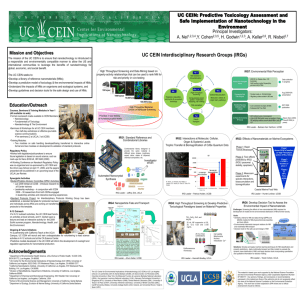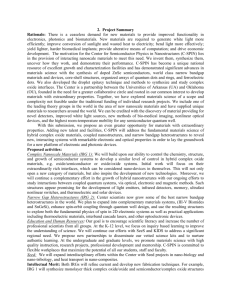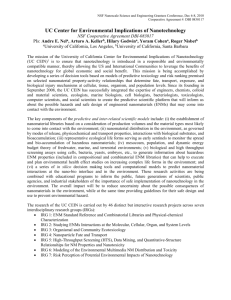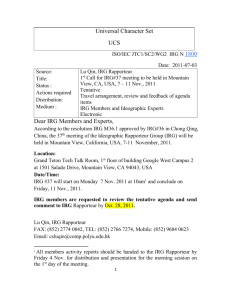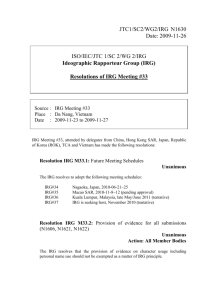UC Center for Environmental Implications of Nanotechnology 083017
advertisement
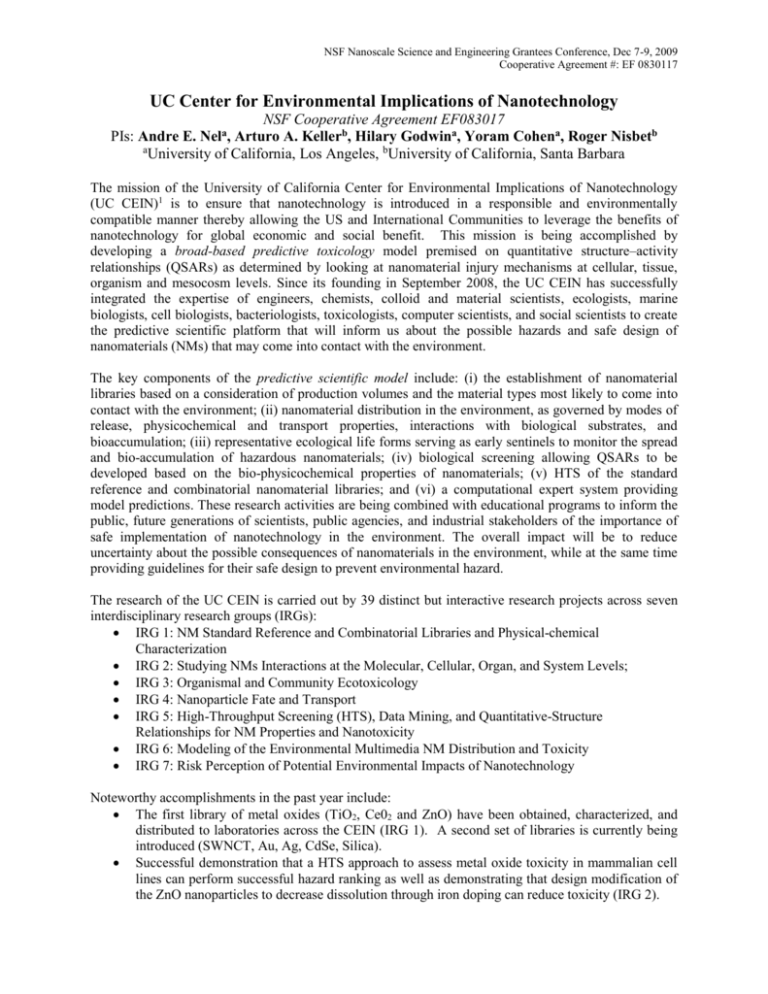
NSF Nanoscale Science and Engineering Grantees Conference, Dec 7-9, 2009 Cooperative Agreement #: EF 0830117 UC Center for Environmental Implications of Nanotechnology NSF Cooperative Agreement EF083017 PIs: Andre E. Arturo A. Kellerb, Hilary Godwina, Yoram Cohena, Roger Nisbetb a University of California, Los Angeles, bUniversity of California, Santa Barbara Nela, The mission of the University of California Center for Environmental Implications of Nanotechnology (UC CEIN)1 is to ensure that nanotechnology is introduced in a responsible and environmentally compatible manner thereby allowing the US and International Communities to leverage the benefits of nanotechnology for global economic and social benefit. This mission is being accomplished by developing a broad-based predictive toxicology model premised on quantitative structure–activity relationships (QSARs) as determined by looking at nanomaterial injury mechanisms at cellular, tissue, organism and mesocosm levels. Since its founding in September 2008, the UC CEIN has successfully integrated the expertise of engineers, chemists, colloid and material scientists, ecologists, marine biologists, cell biologists, bacteriologists, toxicologists, computer scientists, and social scientists to create the predictive scientific platform that will inform us about the possible hazards and safe design of nanomaterials (NMs) that may come into contact with the environment. The key components of the predictive scientific model include: (i) the establishment of nanomaterial libraries based on a consideration of production volumes and the material types most likely to come into contact with the environment; (ii) nanomaterial distribution in the environment, as governed by modes of release, physicochemical and transport properties, interactions with biological substrates, and bioaccumulation; (iii) representative ecological life forms serving as early sentinels to monitor the spread and bio-accumulation of hazardous nanomaterials; (iv) biological screening allowing QSARs to be developed based on the bio-physicochemical properties of nanomaterials; (v) HTS of the standard reference and combinatorial nanomaterial libraries; and (vi) a computational expert system providing model predictions. These research activities are being combined with educational programs to inform the public, future generations of scientists, public agencies, and industrial stakeholders of the importance of safe implementation of nanotechnology in the environment. The overall impact will be to reduce uncertainty about the possible consequences of nanomaterials in the environment, while at the same time providing guidelines for their safe design to prevent environmental hazard. The research of the UC CEIN is carried out by 39 distinct but interactive research projects across seven interdisciplinary research groups (IRGs): IRG 1: NM Standard Reference and Combinatorial Libraries and Physical-chemical Characterization IRG 2: Studying NMs Interactions at the Molecular, Cellular, Organ, and System Levels; IRG 3: Organismal and Community Ecotoxicology IRG 4: Nanoparticle Fate and Transport IRG 5: High-Throughput Screening (HTS), Data Mining, and Quantitative-Structure Relationships for NM Properties and Nanotoxicity IRG 6: Modeling of the Environmental Multimedia NM Distribution and Toxicity IRG 7: Risk Perception of Potential Environmental Impacts of Nanotechnology Noteworthy accomplishments in the past year include: The first library of metal oxides (TiO2, Ce02 and ZnO) have been obtained, characterized, and distributed to laboratories across the CEIN (IRG 1). A second set of libraries is currently being introduced (SWNCT, Au, Ag, CdSe, Silica). Successful demonstration that a HTS approach to assess metal oxide toxicity in mammalian cell lines can perform successful hazard ranking as well as demonstrating that design modification of the ZnO nanoparticles to decrease dissolution through iron doping can reduce toxicity (IRG 2). NSF Nanoscale Science and Engineering Grantees Conference, Dec 7-9, 2009 Cooperative Agreement #: EF 0830117 Demonstration that exposure of various environmental life forms to the first metal oxide library is indeed successful at demonstrating ecological responses, including TiO2 impact on freshwater algae; ZnO effects on seed germination in plants; and effects on bacterial toxicity (IRG 2/3) Early studies find that ZnO is very toxic to the development of sea urchin embryos. Effects are seen at concentrations that are approximately 10-100 times less than in previously reported aquatic systems. (IRG 3). Studies examining the effects of exposure to Quantum Dots (CdSe) across trophic levels show the destructive effects of biomagnifications of these NP through the lower trophic levels, which could implicate an even more extreme condition at higher trophic levels, including fish and mammals (IRG 2/3). Fresh water ecology studies are underway to develop a predictive model that explains how the diversity of species in a freshwater food-web influences the accumulation of nanomaterials in higher trophic levels. Initial experiments have shown that TiO2 stimulates the growth of a wide range of freshwater algae, leading to accumulation of TiO2 in the tissues of higher trophic levels (IRG 3). Protocols are being established to generate a matrix of nanoparticle dispersions and aggregation under groundwater, freshwater, seawater in tissue culture media conditions so as to inform about the fate and transport of the first metal oxide library (IRG 4). Work with metal oxide NPs has shown that they can be easily stabilized under freshwater conditions, which is a major pathway from the sources (e.g. wastewater treatment plant discharge, stormwater, other runoff) into other environmental compartments, such as estuaries and oceans, where the particles sediment rapidly. This has important implications for aquatic organisms that are exposed to particles either in the water column or sediments (IRG 4). Development and implementation of a HTS screening that reveals integrated hierarchical oxidative stress responses to the metal oxides in mammalian and yeast culture media (IRG 5). A new efficient computer algorithm for feature selection ranking was developed for screening and ranking nanoparticle properties for the development of quantitative property-structure relationships. The applicability of the method was demonstrated with databases from the machine learning repository, polymeric nanoparticles insulin retention data, and TiO2 nanotoxicity. (IRG 6) International Survey of nano industry EHS officers regarding NM environmental irsks and perceptions in the field (Fall 2009) (IRG 7). A major goal of the UC CEIN is to train the next generation of nano-scale scientists, engineers, and regulators to anticipate and mitigate potential future environmental hazards associated with nanotechnology. Our educational programs are developed to broaden the knowledge base of the environmental implications of nanotechnology through academic coursework, world-class research, training courses for industrial practitioners, and a journalist–scientist communication program. Significant progress has been made on several of our Education and Outreach goals that enhance our ability to have a broader impact on the scientific, educational, and policy communities both nationally and internationally. These include: i) activities that integrate across IRGs to ensure a unified and effective approach to mentoring and training both students and postdoctoral researchers; and ii) activities focusing on communicating the findings of the UC CEIN to a broader audience and varied constituencies with the goal to framing these findings to provide a scientific basis for related policy and regulatory decisions. Specifically, significant progress has been made in the development of new graduate level courses, implementing internet-based technologies to expand both graduate and undergraduate level course offerings (“Nanotoxicology” in Fall 2008; “Fundamentals of Toxicology” in Spring 2009; “Environmental Nanotechnology” in Spring 2009) , and developing online training modules for safe handling of nanomaterials for use in research and industrial laboratory applications. A series of seminars NSF Nanoscale Science and Engineering Grantees Conference, Dec 7-9, 2009 Cooperative Agreement #: EF 0830117 on Environmental Implications of Nanotechnology and two workshops on effective communication between scientists and journalists were held at UCSB in fall 2008 and winter 2009 and made available to center members across the US and internationally using the webcasting system. In addition, we coorganized a Working Conference on Nanotech Regulatory Policy held on the UCLA campus on April 17, 2009 (http://www.cnsi.ucla.edu/NanoRegulatoryPolicy/) and jointly organized (with the CEINT) the first International Conference on Environmental Implications of Nanotechnology that was held at Howard University in Washington, D.C. on September 9-11, 2009. Planning is currently underway for the Second International Conference on Environmental Implications of Nanotechnology (UCLA Campus, May 2010), as well as for the expansion of course materials and seminars made available in an online format. Additionally, we have partnered with the California Science Center in Los Angeles and will be conducting a series of activities for the public in conjunction with the 2010 NanoDays. References 1 For additional information about the Center and its projects, please visit http://cein.cnsi.ucla.edu. 2 The UC CEIN is headquartered at UC Los Angeles in partnership with UC Santa Barbara, UC Davis, UC Riverside, Columbia University, University of Texas El Paso, Nanyang Technological University (Singapore), the Molecular Foundry at Lawrence Berkeley National Laboratory, Lawrence Livermore National Laboratory, Sandia National Laboratory/University of New Mexico, the University of Bremen (Germany), University of British Colombia (Canada), Cardiff University (Wales), University College Dublin (Ireland), and the Universitat Rovira i Virgili (Spain). Key Publications 1. Nel, A.E., Maedler, L., Velegol, D., Xia, T., Hoek, E.M., Somasundaran, P., Klaessig, F., Castranova, V., and Thompson, M.Understanding biophysicochemical interactions at the nano–bio interface. Nature Materials 8, 543-557 (14 June 2009) doi:10.1038/nmat2442 2. Godwin, Hilary; Chopra, Kabir; Bradley, Kenneth; Cohen, Yoram; Harthorn, Barbara; Hoek, Eric; Holden, Patricia; Keller, Arturo; Lenihan, Hunter; Nisbet, Roger; Nel, Andre. The University of California Center for the Environmental Implications of Nanotechnology. Environmental Science &Technology, 2009, es2008-034544.R1. doi:101.1021/es8034544 3. T. Xia, M. Kovochich, M. Liong, L. Madler, B. Gilbert, H. Shi, J. Yeh, J. I. Zink and A. E. Nel, Comparison of the Mechanism of Toxicity of Zinc Oxide and Cerium Oxide Nanoparticles Based on Dissolution and Oxidative Stress Properties, ACS Nano, 2008, 2, 2121-2134, 10.1021/nn800511k. 4. Priester, John; Stoimenov, Peter; Mielke, Randall; Webb, Sam; Ehrhardt, Christopher; Zhang, Jinping; Stucky, Galen; Holden, Patricia, Effects of Soluble Cadmium Salts Versus CdSe Quantum Dots on the Growth of Planktonic Pseudomonas aeruginosa, Environmental Science & Technology, 2009, 43(7), 2589-2594, 10.1021/es802806n. 5. Satterfield, T., Kandlikar, M., Beaudrie, C, Conti, J., Harthorn,B., Anticipating the Perceived Risk of Nanotechnologies: Will They Be Like Other Controversial Technologies? Nature Nanotechnology. Pulished online September 20, 2009. http://www.nature.com/doifinder/10.1038/nnano.2009.265 6. S. Pokhrel, T. Xia, M. Kovochich, M. Liong, M. Schwalter, A. Rosenauer, B. Gilbert, J. I. Yink, A. E. Nel, L. Mädler, Comparison of the mechanism of toxicity of binary and mixed binary metal oxide nanopartilces based on dissolution and oxidative stress properties, Chemie Ingenieur Technik, 2009, 81(8) 1167
